In the realm of manufacturing and industrial engineering, the creation of magnets stands out as a marvel of modern science and technology. Magnets are integral to our daily lives, powering everything from household appliances to sophisticated medical devices and also renewable energy solutions. At Goudsmit UK, we pride ourselves on not just being a part of this vital industry but also on our commitment to innovation and quality. This blog post takes you behind the scenes to unveil the fascinating journey of magnet production, from the extraction of raw materials to the final assembly. Moreover, we’ll explore how our Magnetic Force Calculator can optimise your projects by ensuring you select the most suitable magnet for your needs.
The Magnet Manufacturing Process: A Step-by-Step Guide
1. Raw Material Sourcing
The journey begins with the sourcing of raw materials. The primary ingredient in most magnets is iron, combined with various alloys such as neodymium, boron, and samarium. This is depending on the type of magnet being produced. These materials are mined from the earth, therefore, requiring a detailed understanding of geology and sustainable mining practices to ensure environmental impact is minimised.
2. Alloying and Melting
Once sourced, the raw materials are alloyed and melted in a high-temperature furnace. This process requires precise control over temperature and timing to achieve the desired magnetic properties. The molten alloy is then cooled and solidified into bars.
3. Milling and Orienting
The bars are then broken down into smaller particles through a milling process. This step is crucial for creating the right particle size and texture for the magnets. Following milling, the particles are oriented in a magnetic field. This step aligns the particles’ magnetic domains and significantly enhances the magnet’s strength.
4. Pressing and Sintering
Next, the oriented particles are pressed into a die to form the magnet’s shape. This can be done under various conditions, including room temperature (cold pressing) or elevated temperature (hot pressing). The pressed magnets are then sintered in a furnace, which bonds the particles together at a molecular level, further increasing their magnetic strength.
5. Machining and Coating
After sintering, the magnets are machined into their final shapes and sizes. Precision machining ensures that the magnets meet the strict tolerances required for specific applications. Moreover, to protect the magnets from corrosion and enhance their physical properties, a coating is applied. Common coatings include nickel, zinc, and epoxy.
6. Magnetisation and Testing
The final step in the manufacturing process is to magnetise the magnets. This is done using a powerful magnetic field that aligns the domains in the direction of the desired magnetic pole. After magnetisation, rigorous testing is conducted to ensure each magnet meets Goudsmit UK’s high standards for magnetic strength, durability, and also performance.
Optimising Your Projects with Goudsmit UK’s Magnetic Force Calculator
One of the key challenges in utilising magnets in any project is selecting the right magnet for the job. This is where Goudsmit UK’s Magnetic Force Calculator comes into play. This innovative tool allows engineers, designers, and project managers to input specific parameters of their projects and receive recommendations on the most suitable magnets for their applications. It considers factors such as magnet shape, dimensions, and material, ensuring that every project benefits from the optimal magnetic solution.
Check out our magnetic force calculator here.
Goudsmit UK
The manufacturing of magnets is a complex, multi-step process that requires precision, expertise, and a deep understanding of physics and materials science. Goudsmit UK is at the forefront of this industry, offering not only high-quality magnets but also tools like the Magnetic Force Calculator to ensure our clients’ projects are successful. Whether you’re involved in industrial engineering, product design, or any field that relies on magnetic technology, understanding how magnets are made can provide valuable insights into their potential applications and benefits.
To learn more about our custom magnets visit our magnetic products webpage.
Download our comprehensive products and services brochure here.







